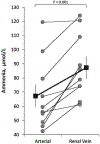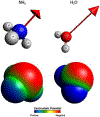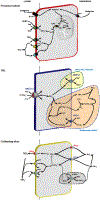Emerging Features of Ammonia Metabolism and Transport in Acid-Base Balance
- PMID: 31300094
- PMCID: PMC6629433
- DOI: 10.1016/j.semnephrol.2019.04.008
Emerging Features of Ammonia Metabolism and Transport in Acid-Base Balance
Abstract
Ammonia metabolism has a critical role in acid-base homeostasis and in other cellular functions. Kidneys have a central role in bicarbonate generation, which occurs through the process of net acid excretion; ammonia metabolism is the quantitatively greatest component of net acid excretion, both under basal conditions and in response to acid-base disturbances. Several recent studies have advanced our understanding substantially of the molecular mechanisms and regulation of ammonia metabolism. First, the previous paradigm that ammonia transport could be explained by passive NH3 diffusion and NH4+ trapping has been advanced by the recognition that specific transport of NH3 and of NH4+ by specific membrane proteins is critical to ammonia transport. Second, significant advances have been made in the understanding of the regulation of ammonia metabolism. Novel studies have shown that hyperkalemia directly inhibits ammonia metabolism, thereby leading to the metabolic acidosis present in type IV renal tubular acidosis. Other studies have shown that the proximal tubule protein NBCe1, specifically the A variant NBCe1-A, has a major role in regulating renal ammonia metabolism. Third, there are important sex differences in ammonia metabolism that involve structural and functional differences in the kidney. This review addresses these important aspects of ammonia metabolism and transport.
Keywords: Ammonia; NBCe1; chronic kidney disease; glutamine synthetase; hepatic encephalopathy; lithium.
Published by Elsevier Inc.
Figures






References
-
- Nonoguchi H, Takehara Y, Endou H. Intra- and inter-nephron heterogeneity of ammoniagenesis in rats: effects of chronic metabolic acidosis and potassium depletion. Pflugers Arch. 1986; 407:245–51. - PubMed
-
- Moret C, Dave MH, Schulz N, Jiang JX, Verrey F, Wagner CA. Regulation of renal amino acid transporters during metabolic acidosis. Am J Physiol Renal Physiol. 2007; 292:F555–F566. - PubMed
Publication types
MeSH terms
Substances
Grants and funding
LinkOut - more resources
Full Text Sources

